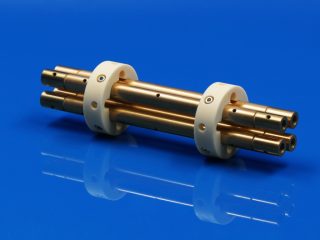Semiconducting ceramics refer to ceramics with semiconducting properties and a conductivity of about 10-6~105/m. The conductivity of semiconducting ceramics changes significantly due to changes in external conditions (temperature, light, electric field, gas and temperature, etc.) , so changes in physical quantities of the external environment can be converted into electrical signals and made into sensitive components for various purposes.
Semiconductor-99.7-Alumina-Ceramic-Wafer-Robotic-Arm
1. Thermosensitive ceramics: also known as thermistor ceramics, refer to ceramics whose electrical conductivity changes significantly with temperature. Among them, heat-sensitive semiconductor ceramic tubes and heat-sensitive ceramics are mainly used in temperature compensation, temperature measurement, temperature control, fire detection, overheat protection and color TV degaussing, etc.
2.Photosensitive ceramics: refer to ceramics with photoconductive or photovoltaic effects. Such as cadmium sulfide, cadmium telluride, gallium arsenide, phosphide smoke, bismuth germanate and other ceramics or single crystals, when the light reaches its surface, the conductance increases, and it is mainly used as a semiconductor for automatic control of optical switches and solar cells. Ceramics
Semiconductor-99.7-Alumina-Ceramic-Wafer-Robotic-Arm
3. Gas-sensitive ceramic zirconia semiconductor ceramics
Gas-sensitive ceramics: Refers to ceramics whose electrical conductivity changes with the type of gas molecules they are in contact with. Ceramics such as zinc oxide, tin oxide, iron oxide, vanadium pentoxide, zirconia, nickel oxide and cobalt oxide. It is mainly used for leak detection, disaster prevention alarm and measurement of different gases.
4. Humidity-sensitive ceramics: refers to ceramics whose electrical conductivity changes significantly with humidity. Ceramics such as ferroferric oxide, titanium oxide, potassium oxide-iron oxide, magnesium chromate-titanium oxide and zinc oxide-lithium oxide-vanadium oxide are particularly sensitive to water and are suitable for measuring humidity. and control.




 Enquiry
Enquiry